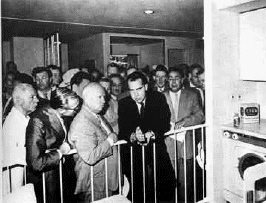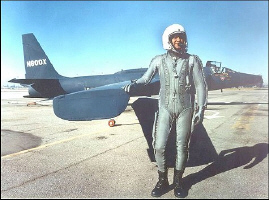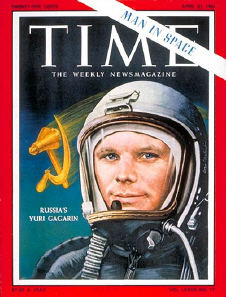Multiple Choice
Identify the
choice that best completes the statement or answers the question.
|
|
|
The Soviet atomic bomb gives
started an arms race between the U.S. and the Soviets. Who was going to have the most powerful
military? After the Soviets were the first to put a satellite into space a space race between the
“Super Powers” started.Now the U.S. and the Soviets had thousands of missiles pointed at
each other. Any promising technological advances are overshadowed by the threat of long-range nuclear
destruction.
DUCK &
COVER
In August 1949, the
United States finds itself shocked to discover the Soviet Union has broken Washington's atomic
monopoly. The new Soviet bomb was developed quickly, thanks to the acquisition of U.S. atomic secrets
by Soviet agents. The bomb also signals the start of the nuclear arms race between the Cold War
rivals.
By 1952, the United States develops and tests the first hydrogen bomb. The Soviets match
that milestone several years later. Meanwhile, American children watch as bomb shelters are dug in
their backyards and learn in school to "duck and cover" should nuclear bombs fall in their
neighborhoods

|
|
|
1.
|
The arms race was
...
a. | a competition between the U.S. and
Russia to see who had the best boxers | c. | a race to see who would have the best
scientists. | b. | a race between the U.S. and the Soviets to see who had the superior
military | d. | a race to see who would be superior
in space, U.S. or the Soviets |
|
|
|
2.
|
Why did American children
practice “duck and cover” in school during the 1950’s
a. | Americans were worried about natural
disasters like earthquakes | c. | Americans were worried about Soviet nuclear
attacks | b. | It had been a part of the fire safety program in schools for
years | d. | This was a way that the government had to frighten the
population so they would okay more money for defense. |
|
|
|
3.
|
What was the Washington
monopoly that the Soviets broke?
a. | a spy ring in the U.S. State
Department | c. | civil defense
procedures like, “duck and cover. | b. | the U.S. was the only nation to have atomic weapons in the early
50’s | d. | American military codes that enabled
Russia to listen to our secrets |
|
|
|
SPUTNIK
In 1952, Dwight Eisenhower was elected to succeed Harry Truman as U.S.
president. Less than a year later, Soviet dictator Joseph Stalin was dead, starting a power struggle
among the Kremlin leadership. In 1955, Eisenhower met with a Soviet delegation in Geneva and proposed
an "Open Skies" policy -- giving both sides the freedom to fly over each other's
territory and observe for themselves military developments on the ground. Nikita Khrushchev, then
emerging as top Soviet leader, announced his delegation's refusal.
Soviet engineers,
meanwhile, had been busy developing missile technology. They tested the world's first
intercontinental ballistic missile in May 1957. And on October 4 of that year they surprised the
world by launching Sputnik -- the world's first satellite.
|
|
|
4.
|
President Eisenhower proposed
to the Soviets that both sides be allowed to fly over the other sides territory so neither side would
have to worry about a surprise attack. What was the policy called?.
a. | Open Sky
Policy | c. | Eisenhower
Doctrine | b. | Truman Doctrine | d. | Cold War Policy |
|
|
|
5.
|
What did intercontinental
ballistic missiles allow the Soviets to do?
a. | Knock down any incoming American
missiles | c. | The Soviets could
attack Europe but not the U.S. | b. | Improve their domestic economy | d. | The Soviets could now hit the U.S. with atomic
weapons |
|
|
|
6.
|
Which statement below is
False?
a. | In the early 50’s the Soviets
seemed to be ahead of the U.S. in space technology | c. | The Soviets were the first to put a satellite in
space | b. | The U.S. was not concerned about Soviet scientific advances because we had a
superior military. | d. | The Soviets were the first to launch
develop an intercontinental missile |
|
|
|
7.
|
After the death of Stalin in
1953, who was emerging as the new Soviet leader?
a. | Joseph
Stalin | c. | No one, because of the power
struggle | b. | V.I. Lenin | d. | Nikita Kruschev |
|
|
|
CATCH-UP
Sputnik came as a shock to the West and especially the United States, which
realized the Soviets now had the ability to send not only satellites around the world, but nuclear
weapons as well. The U.S. military tried to push forward with its own satellite, called Vanguard, but
the first attempt to launch Vanguard was a spectacular failure. Eventually, with the help of German
scientist Werner von Braun, the Explorer satellite was fired into space on top of a military Redstone
missile.

Krushchev and Nixon in the Kitchen
Debate | In 1959, Khrushchev became the first Soviet leader to visit the United States.
While he and Eisenhower spent part of the visit discussing ways to slow the arms race,
Khrushchev's visit is best remembered for his ideological sparring with then-U.S. Vice President
Richard Nixon. Krushchev and Nixon argued about the superiority of the Soviet or U.S. political
system. In this debate Krushchev made the famous statement, “We will bury
you.” | | |
|
|
|
8.
|
Early attempts by the U.S. to
catch up to the Russians in missile technology were
a. | successful because of
Vanguard | c. | a
failure | b. | showed our superiority in technology | d. | showed that the Soviets had the atomic bomb but no way to deliver it to the
U.S. |
|
|
|
9.
|
In 1959, _____ was president of
the United States and _____ was vice president.
a. | Eisenhower -
Nixon | c. | Khrushchev -
Eisenhower | b. | Nixon - Eisenhower | d. | Eisenhower - Von Braun |
|
|
|
10.
|
What did Eisenhower and
Krushchev discuss on his visit to the U.S. in 1959?
a. | Ways to slow the technology
developments | c. | The division of
Germany | b. | Ways to slow the arms race | d. | Ways to use German scientists to slow the arms
race |
|
|
|
11.
|
In his visit to the U.S. in
1959, Krushchev demonstrated
a. | that the Soviet System was
inferior | c. | fear of another
nuclear war with the U.S. | b. | confidence in the superiority of Soviet
Technology | d. | fear of superior American
technology |
|
|
|
12.
|
Soviet rockets are to Sputnik
as Redstone is to _____
a. | Khrushchev | c. | Sputnik | b. | Von Braun | d. | Explorer |
|
|
|

Francis Gary Powers and the U-2 spy plane | U-2
Eisenhower was concerned about how big the "missile gap" was between the
United States and Soviet Union. U.S. reconnaissance planes, designated U-2s, secretly flew over the
U.S.S.R., looking for evidence of missiles. On one such mission, a U-2 was shot down by the Soviet
military.
Despite U.S. denials, the Soviets presented as evidence the plane's wreckage -- as
well as its pilot, Francis Gary Powers, who had survived the shoot-down. Khrushchev and Eisenhower
were scheduled to meet in Paris for a Summit meeting to talk about ways to ease Cold War tensions.
The U-2 incident undermined a Paris summit several weeks later between Khrushchev and Eisenhower and
Khrushchev refused to go. Powers was sentenced to prison but was later exchanged for a Soviet
spy | | |
|
|
|
13.
|
Why did the U.S. send U-2
planes over the Soviet Union
a. | to learn about Soviet
missiles. | c. | to promote
peace | b. | to promote goodwill | d. | to prepare for a U.S. attack on the Soviet
Union |
|
|
|
14.
|
What is a summit
meeting?
a. | A meeting at the United
Nations | c. | A meeting between
leaders at Summit, Switzerland | b. | A meeting between the heads of states to discuss some
issue | d. | A meeting between members of
Congress |
|
|
|
15.
|
What was
U-2?
a. | A rock music
group | c. | A Russian Spy
plane | b. | A united summit between 2 people | d. | An American Spy plane |
|
|
|
16.
|
How did the Russians treat
Francis Gary Powers after he was shot down?
a. | Tried him as a spy and put him in
prison | c. | Released him to ease tensions
between the U.S. and the Soviet Union | b. | Tried him as a spy and executed him | d. | Exiled him to Russian Siberia |
|
|
|
17.
|
Eisenhower was to the United
States as Khrushchev was to
________
a. | the space
program | c. | the Soviet
Union | b. | the U-2 spy plane | d. | Francis Gary Powers |
|
|
|
DISASTER/TRIUMPH
At the time, the United States thought the Soviet Union was far ahead in
rocket and space technology. In fact, it was later learned that the Soviets were not so far ahead as thought.
Khrushchev feared the American U-2 flights had exposed his claims of missile superiority as a bluff.
At the Baikonur Cosmodrome, engineers under the command of Marshal Nedelin were ordered to create a
new missile. During the rush to production, a fire erupted -- killing nearly 200 people.
While
the Soviets were behind in the missile race, they still had one card to play: Yuri Gagarin. On
April 12, 1961, Gagarin achieved international acclaim when he became the first human to be
launched into space.
|
 | | |
|
|
|
18.
|
What country was first to put a
man in space?
a. | United
States | c. | Soviet
Union | b. | Germany | d. | Great Britain |
|
|
|
19.
|
In 1960 which country was ahead
in missile and space technology?
a. | Soviet
Union | c. | Germany | b. | United States | d. | No one was ahead |
|
|
|
20.
|
How did the U.S. learn that the
Soviets were having problems with their space program?
a. | pictures of the Soviet Union taken
from the U-2 spy planes | c. | Time magazine
reports that Yuri Gagarin died along with 200 people at a Soviet space disaster
| b. | the spy work of Alger
Hiss | d. | The Soviets were not having problems with their space
program |
|